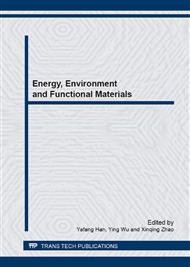p.152
p.159
p.164
p.171
p.176
p.184
p.195
p.198
p.205
Comparative Study on Life Cycle Assessment for Typical Building Thermal Insulation Materials in China
Abstract:
Studies on life cycle assessment of three typical building thermal insulation materials including polystyrene board, rock wool board, and rigid foam polyurethane board related to building energy-saving were carried out. Based on the method of life cycle assessment, "1 kg of thermal insulation material" is first selected as one of the functional units in this study based on the production field data statistics and general market transaction rules of the thermal insulation materials, and life cycle resource consumption, energy consumption and exhaust emission of the three products in China are deeply surveyed and analyzed. The abiotic depletion potential (ADP), primary energy demand (PED), and global warming potential (GWP) for production of 1 kg of the three thermal insulation materials are calculated and analyzed. Furthermore, the functional unit is extended to be "1 m2 of thermal insulation material meeting the same energy-saving requirements" so as to compare the difference of environmental friendliness among the three building thermal insulation materials, and the corresponding life cycle environmental impact is also calculated and analyzed. As shown by the results, where calculated in unit mass, the order of production life cycle environmental impact significances of the thermal insulation materials is as follows: rock wool board < polyurethane board < polystyrene board. However, where calculated in unit area (m2) meeting the 65% energy-saving requirements, the production life cycle environmental impact significances of the three kinds of insulation materials are sorted as polystyrene board < polyurethane board < rock wool board, whatever the region is, which is opposite with that of the results for the insulation materials in unit mass (kg). The reason for such difference is that they have different volume weights and heat conductivity coefficients. The polystyrene board has a smaller volume weight and the smallest heat conductivity coefficient, whereas the rock wool board has the highest volume weight and heat conductivity coefficient. Source of the project fund. Subject "the Research and Application of Life Cycle Assessment Technology to the Building Materials for Building Engineering in Typical Regions" of the National Science & Technology Pillar Program during the Twelfth Five-year Plan Period (No.: 2011BAJ04B06)
Info:
Periodical:
Pages:
176-183
Citation:
Online since:
April 2014
Authors:
Price:
Сopyright:
© 2014 Trans Tech Publications Ltd. All Rights Reserved
Share:
Citation:


